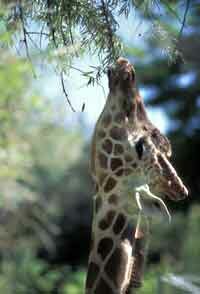 Reticulated Giraffe Reticulated Giraffe
scientific name
Giraffa camelopardalis reticulata
size/weight/height
Height: male up to 18' " female 13 - 15'
Weight: male 1,765 - 4,255 lbs. " female 1,215 - 2,600 lbs.
Tail Length: maximum 3'
adaptations/coloration
Color/Pattern: pattern identifies individual; vary between individuals & sub-species (not accurate way to differentiate sub-species); chestnut patches large & regular in reticulated subspecies " narrow white lines separate
Hide: thick
Horns: one of few ruminants born with horns " present on both sexes (male slightly larger) " covered with skin " lie flat at birth " become upright & bony 1st week
Legs: forelegs longer than hind-legs (slopes toward rear)
Neck: height requires that series of valves regulate flow of blood to head
Senses: sight most developed " hearing & smell very acute
Tail: may have hair tassel " tuft used as fly swatter
Vertebrae: 7 mammalian cervical but elongated " 4th & 5th thoracic have large, forward-facing dorsal spines (the conspicuous shoulder hump) " serve as neck muscles attachment point
Voice: normally silent " can produce variety grunts & snorts " calves bleat
behavior
Defense: head & horns used in fights between males " serious injury rare " strong hooves
Feeding: sexes differ " very specific " males eat tree canopy with neck outstretched " females eat neck curved over - body to knee height
Group: herd transitory & scattered " members constantly changing
Social Order: bulls not territorial " bulls coexist in overlapping ranges " hierarchy among males exists " each individual knows status
reproduction/lifespan
Lifespan: wild ~25 yrs " captivity record 28 yrs
Birth Site: same site used continuously by many generations
Breeding: majority of successful breeding by few top males
Calves: begin forming groups 1 - 2 weeks
Gestation: ~15 mos.
Parenting: mom - excellent " defends calf from anyone & anything " leaves calf during heat of day to graze
Predators of Calves: lions (main), African wild dogs, hyenas & leopards " mortality 1st yr. 58% (but population still increases 5-6% annually)
Sexual Maturity: male ~3.5 yrs " female ~5 yrs
Young: twins extremely rare
Birth Interval: ~2 yrs.
diet
Wild: exclusively highly selected browsers, flowers, fruits, herbs, leaves, seeds, new shoots & vines
Zoo: alfalfa hay & grains
habitat/range
open woodland " wooded grassland " Sub-Saharan Africa
status
not listed " some populations being wiped out in Kenya to provide tourists with fly swatters, bags or buckets
oregon zoo exhibit
Africa Savanna
back to top
|


